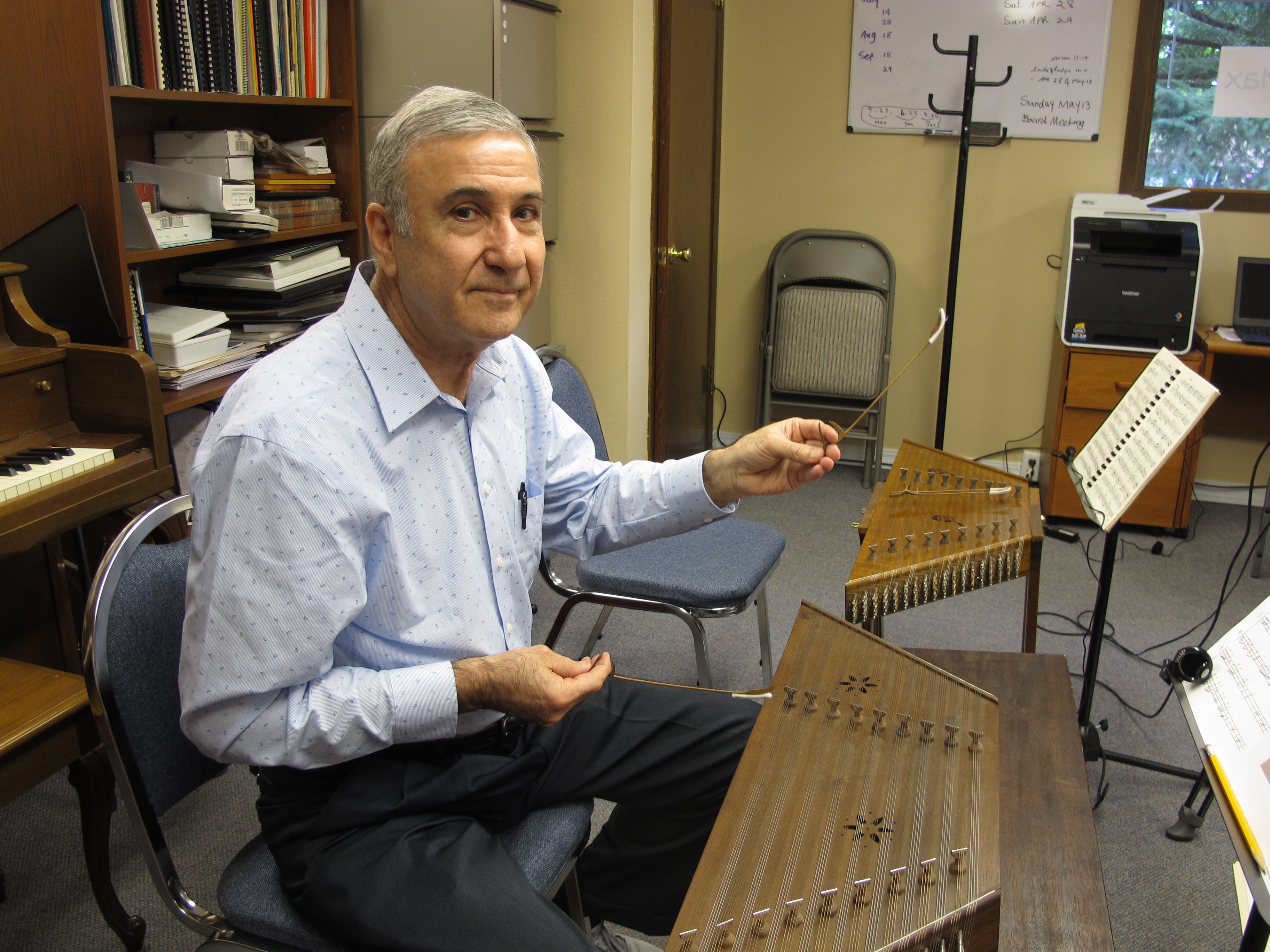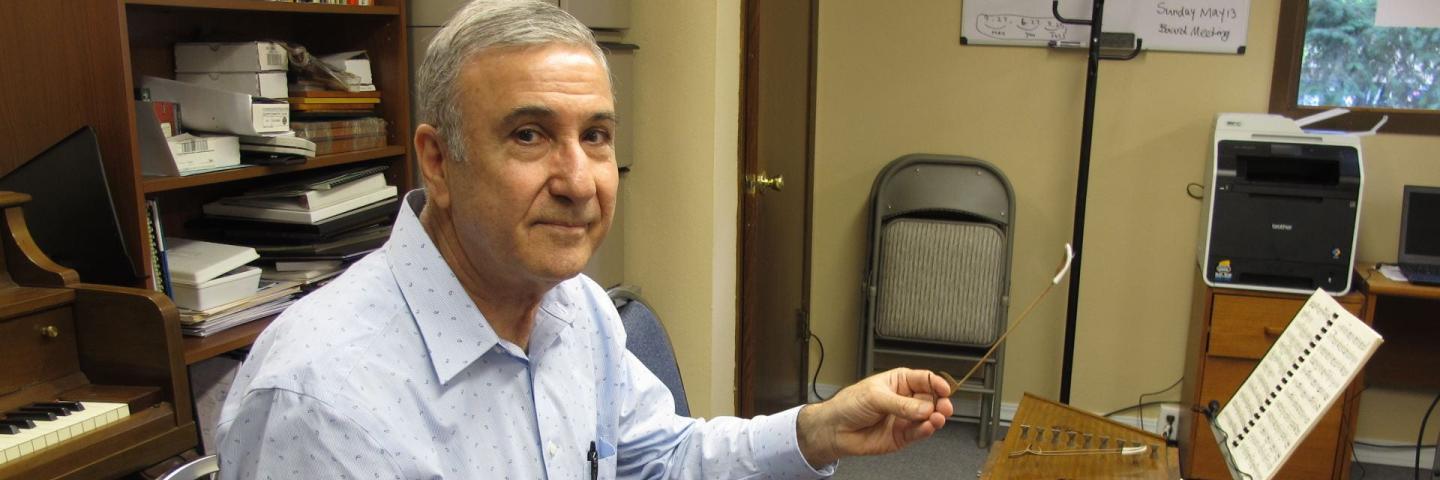 | Traditional Skill/Art: Persian santoor player Years Awarded: 2016, 2019, 2021 Contact Information: Phone: (503)579-3431 Email: hossein.salehi@comcast.net
|
ARTIST BIOGRAPHY
In 1987, when my family and I migrated to the United States, I was unable to bring my instrument and purchasing one here in Oregon was not an option; it simply did not exist. Homesick, and with the help of a friend with a talent for woodworking, I built my first Santoor. I was invited to present advance applied music course at PSU for two years 2012 and 2013 where I passed on my unique techniques to one of my highest quality students Monica Rabii. She was the very first graduate from PSU with bachelor degree on special instrument "Santoor." This unprecedented event was the utmost fulfilling event in my artistic life.
Hossein Salehi was also a Traditional Arts Apprenticeship Program awardee in 2016, when he worked with Amitis Moradkhani. In 2022, he is working with Noveen Eshraghi.
APPRENTICE BIOGRAPHY - Noveen Eshraghi 2021
Noveen Eshraghi is a young musician who was born to an Iranian family based in Oregon. He started learning to play Santoor from a young age and has been a student of Hossein Salehi for over 4 years. Noveen has taken part in numerous performances and shows in addition to having reached level 5 of traditional Santoor playing in Fall 2021.
APPRENTICE BIOGRAPHY - Alireza Talebannejad 2019
Alireza Talebannejad is a 19-year-old boy raised in Iran who moved to the US with his family. Growing up listening to Persian music in Iran, Talebannejad always wanted to learn to play the Santoor and master the instrument. After receiving a scholarship to do so, he began classes with Salehi to learn the Santoor. He wishes to continue his studies of the instrument and be able to teach others in his community and university.
APPRENTICE BIOGRAPHY - Amitis Moradkhani 2016
Amitis Moradkhani is a young Iranian-American girl raised in a Persian family. She grew up listening to Persian music either during her visits to Iran to visit family or here in her local community. She began playing piano at the age of five, but a year ago decided to bridge the gap between her love of music and cultural heritage and began learning the Santoor. She plans to continue her education and passion of Persian music and seeks to keep performing in her community to showcase Persian culture.
Q&A WITH THE MENTOR ARTIST
Describe your traditional art.
Body
Traditional Santoor playing is a very common in Persian culture and has been used in traditional Persian music for over 1,100 years. This form of music is played very commonly in ceremonies, celebrations, national holidays, and more. All formal and historical Persian celebrations have their own melodies, along with their own related lyrics; it is very important to keep this tradition alive and pass it onto next generations.
In 1987, when my family and I migrated to the United States, I was unable to bring my instrument and purchasing one here in Oregon was not an option; it simply did not exist. Homesick, and with the help of a friend with a talent for woodworking, I built my first Santoor. I was invited to present advance applied music course at PSU for two years 2012 and 2013 where I passed on my unique techniques to one of my highest quality students Monica Rabii. She was the very first graduate from PSU with bachelor’s degree on special instrument "Santoor." This unprecedented event was the utmost fulfilling event in my artistic life.
How did you come to learn this tradition?
Body
When I was a small child, I attended my first concert with my father Maestro Abbas Selehi, a gifted violinist. There I fell in love with what I perceived to be an enchanted box – the Santoor or Hammered Dulcimer. Next month, I picked up my first set of mezrabs (mallets) and was fascinated by the first shimmering sound. After teaching me the principles of the traditional art form, my father registered me in a specialized intermediate music class in Tehran, and eventually advanced classes. By age ten, I was competing in and winning musical competitions. By fifteen I was the best in my age group, winning the national first place prize for Santoor playing in Iran, and the opportunity to play alongside renowned Iranian musicians on national television.
Why is this cultural tradition important to your community?
Body
I am fortunate enough to have learned this unique instrument since my childhood and continued developing my skills during the last 61 years of my life. My whole purpose was to train more people familiar with this unique form of Persian instrument in order to keep it alive. Students with Persian background will feel more confident by accessing their traditional cultural aspects.
This type of instrument was unknown in Oregon and throughout the United States, and fellow Iranians/Americans did not have access to their heritage. I committed myself to creating opportunities for others to learn this art form in Oregon and in even in other states. My small, private lessons soon led to large annual recitals, local performances, and to my delight, former students who are now teachers.
Experience/Honors
Body
In 1993 I was awarded as a Persian Master Artists by the Oregon Historical Society
In 2002 I was recognized as a Master Artist in Persian Music by the Andisheh Center
In 2005 I was interviewed by and featured in Oregon Art Beat by Oregon Public Broadcasting
Since 2006 I have taught at annual seminars of Dulcimer Players of the United States and presented santoor and traditional Persian music.
Visit OFN's Culture Keepers Roster to learn more about the artist.
Traditional Arts Apprenticeship Program
More OFN programs
OFN main page
